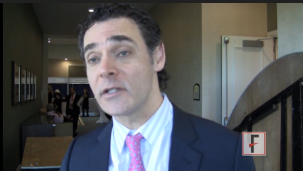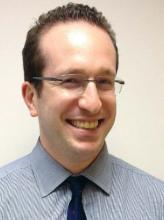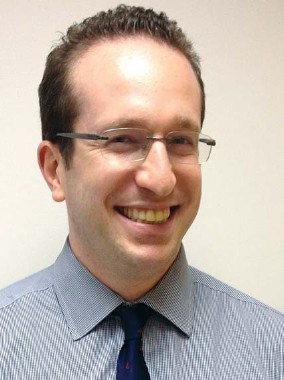User login
Orlando Dermatology Aesthetic and Clinical Conference (ODAC)
VIDEO: Photodynamic therapy pearls can improve results
CHAMPIONSGATE, FLA. – Do you use photodynamic therapy to treat actinic keratoses? Dr. Joel Cohen has some tips for you. At the Orlando Dermatology Aesthetic and Clinical Conference, Dr. Cohen spoke to us about current strategies for making the most of PDT, and which treatment plans work best for certain patients. What’s next for PDT? Dr. Cohen of the department of dermatology at the University of Colorado, Denver, highlights promising preliminary studies involving different types of combination therapies that can yield cosmetic and medical benefits.
The video associated with this article is no longer available on this site. Please view all of our videos on the MDedge YouTube channel
CHAMPIONSGATE, FLA. – Do you use photodynamic therapy to treat actinic keratoses? Dr. Joel Cohen has some tips for you. At the Orlando Dermatology Aesthetic and Clinical Conference, Dr. Cohen spoke to us about current strategies for making the most of PDT, and which treatment plans work best for certain patients. What’s next for PDT? Dr. Cohen of the department of dermatology at the University of Colorado, Denver, highlights promising preliminary studies involving different types of combination therapies that can yield cosmetic and medical benefits.
The video associated with this article is no longer available on this site. Please view all of our videos on the MDedge YouTube channel
CHAMPIONSGATE, FLA. – Do you use photodynamic therapy to treat actinic keratoses? Dr. Joel Cohen has some tips for you. At the Orlando Dermatology Aesthetic and Clinical Conference, Dr. Cohen spoke to us about current strategies for making the most of PDT, and which treatment plans work best for certain patients. What’s next for PDT? Dr. Cohen of the department of dermatology at the University of Colorado, Denver, highlights promising preliminary studies involving different types of combination therapies that can yield cosmetic and medical benefits.
The video associated with this article is no longer available on this site. Please view all of our videos on the MDedge YouTube channel
EXPERT ANALYSIS FROM ODAC
VIDEO: Generational dermatology teaches patients to think long term
CHAMPIONSGATE, FLA. – "Aging doesn’t happen overnight," according to Dr. Wendy Roberts, medical director of Desert Dermatology in Rancho Mirage, Calif.
In a video interview at the Orlando Dermatology Aesthetic and Clinical Conference, Dr. Roberts explained the concept of "generational dermatology" and how dermatologists are uniquely qualified to educate patients about taking a long-term, preventative approach to skin care.
The video associated with this article is no longer available on this site. Please view all of our videos on the MDedge YouTube channel
CHAMPIONSGATE, FLA. – "Aging doesn’t happen overnight," according to Dr. Wendy Roberts, medical director of Desert Dermatology in Rancho Mirage, Calif.
In a video interview at the Orlando Dermatology Aesthetic and Clinical Conference, Dr. Roberts explained the concept of "generational dermatology" and how dermatologists are uniquely qualified to educate patients about taking a long-term, preventative approach to skin care.
The video associated with this article is no longer available on this site. Please view all of our videos on the MDedge YouTube channel
CHAMPIONSGATE, FLA. – "Aging doesn’t happen overnight," according to Dr. Wendy Roberts, medical director of Desert Dermatology in Rancho Mirage, Calif.
In a video interview at the Orlando Dermatology Aesthetic and Clinical Conference, Dr. Roberts explained the concept of "generational dermatology" and how dermatologists are uniquely qualified to educate patients about taking a long-term, preventative approach to skin care.
The video associated with this article is no longer available on this site. Please view all of our videos on the MDedge YouTube channel
EXPERT ANALYSIS FROM THE ODAC CONFERENCE
VIDEO: Try ‘restaurant menu’ approach to laser treatment of scars
CHAMPIONSGATE, FLA. – Patients seeking treatment for scars can benefit from a "restaurant menu" approach that involves using a series of techniques in a single visit, according to Dr. Jill Waibel, medical director of the Miami Dermatology and Laser Institute. At the Orlando Dermatology Aesthetic and Clinical Conference, Dr. Waibel spoke to us about one of her favorite strategies for scar treatment: a multiprocedure, multilaser protocol in a single visit that includes an "appetizer," such as a pulsed dye laser; followed by the "main course" of scar treatment, a fractional ablative device; and then "dessert" of adjunctive and topical therapies.
CHAMPIONSGATE, FLA. – Patients seeking treatment for scars can benefit from a "restaurant menu" approach that involves using a series of techniques in a single visit, according to Dr. Jill Waibel, medical director of the Miami Dermatology and Laser Institute. At the Orlando Dermatology Aesthetic and Clinical Conference, Dr. Waibel spoke to us about one of her favorite strategies for scar treatment: a multiprocedure, multilaser protocol in a single visit that includes an "appetizer," such as a pulsed dye laser; followed by the "main course" of scar treatment, a fractional ablative device; and then "dessert" of adjunctive and topical therapies.
CHAMPIONSGATE, FLA. – Patients seeking treatment for scars can benefit from a "restaurant menu" approach that involves using a series of techniques in a single visit, according to Dr. Jill Waibel, medical director of the Miami Dermatology and Laser Institute. At the Orlando Dermatology Aesthetic and Clinical Conference, Dr. Waibel spoke to us about one of her favorite strategies for scar treatment: a multiprocedure, multilaser protocol in a single visit that includes an "appetizer," such as a pulsed dye laser; followed by the "main course" of scar treatment, a fractional ablative device; and then "dessert" of adjunctive and topical therapies.
EXPERT ANALYSIS FROM THE ODAC CONFERENCE
VIDEO: Sun protection myths debunked
CHAMPIONSGATE, FLA. – Can you separate sun protection myths from facts for your patients? Misperceptions persist, but sunscreen remains a safe and effective tool to help protect the skin from ultraviolet radiation.
In a video interview at the Orlando Dermatology Aesthetic and Clinical Conference, Dr. Adam Friedman of Montefiore/Albert Einstein College of Medicine, New York, debunked several sun protection myths related to oxybenzone, nanoparticles, and vitamin D.
The video associated with this article is no longer available on this site. Please view all of our videos on the MDedge YouTube channel
CHAMPIONSGATE, FLA. – Can you separate sun protection myths from facts for your patients? Misperceptions persist, but sunscreen remains a safe and effective tool to help protect the skin from ultraviolet radiation.
In a video interview at the Orlando Dermatology Aesthetic and Clinical Conference, Dr. Adam Friedman of Montefiore/Albert Einstein College of Medicine, New York, debunked several sun protection myths related to oxybenzone, nanoparticles, and vitamin D.
The video associated with this article is no longer available on this site. Please view all of our videos on the MDedge YouTube channel
CHAMPIONSGATE, FLA. – Can you separate sun protection myths from facts for your patients? Misperceptions persist, but sunscreen remains a safe and effective tool to help protect the skin from ultraviolet radiation.
In a video interview at the Orlando Dermatology Aesthetic and Clinical Conference, Dr. Adam Friedman of Montefiore/Albert Einstein College of Medicine, New York, debunked several sun protection myths related to oxybenzone, nanoparticles, and vitamin D.
The video associated with this article is no longer available on this site. Please view all of our videos on the MDedge YouTube channel
EXPERT ANALYSIS FROM THE ODAC CONFERENCE
How to identify inducible urticaria
CHAMPIONSGATE, FLA. – Physical urticarias, also known as inducible urticarias, comprise 20%-30% of all chronic urticaria cases, and these patients are rarely responsive to corticosteroids, according to Dr. Adam Friedman.
Physical urticarias are often episodic, and spontaneous resolution is less likely in this subset of patients, compared with chronic urticaria patients overall (33% vs. 20%), said Dr. Friedman, director of dermatologic research at Albert Einstein College of Medicine in New York.
Identifying the unique source of a patient’s inducible urticarias is important because it paves the way for more successful treatment, he said at the Orlando Dermatology Aesthetic and Clinical Conference.
Causes of physical urticaria include dermatographism, cholinergic factors, heat, cold, water, sun, and vibration.
To diagnose physical urticaria, ask patients about family history and whether they have pictures documenting the urticaria episodes, Dr. Friedman said. The reaction in patients with physical urticaria is reproducible in response to environmental factors, he noted.
Dr. Friedman described several provocative tests for the most common physical urticarias.
If cold-induced urticaria is suspected, place an ice cube on the forearm to see whether hives occur after it is removed. If patients report hives after sweating or exposure to heat, the heat may be the cause; test by using localized heat (a test tube of water at 44 degrees Celsius).
Less obvious, but genuine, causes of physical urticaria include delayed pressure-induced urticaria and angioedema, which may be the culprit in patients who report swelling in the shoulder within 4-6 hours after carrying a heavy purse or other shoulder bag. To test for this trigger in the office, use a 15-pound sandbag on the target area. In cases of aquagenic urticaria, patients develop hives with exposure to water, which can be reproduced with a wet compress. And, believe it or not, individuals can develop vibratory-induced urticaria on the hands after mowing the lawn (this one is harder to reproduce in the office).
For physical urticaria, as with any type, "Make sure you have the right diagnosis," Dr. Friedman said. The patient may come in without anything on the skin, complaining of episodes of hives. The urticarial differential diagnosis is quite extensive, so a good history is important to clinching the diagnosis.
Biopsies and lab tests aren’t usually helpful for physical urticarias, Dr. Friedman said, "but if something suggests a workup, go after it."
The treatment of physical urticaria can be complicated, and includes both avoiding triggers (if possible) and managing the inflammatory response. The first-line preference is high-dose, second-generation H1 antihistamines. "You can go as high as fourfold the recommended daily dose," Dr. Friedman said.
"Don’t be afraid to try some off-label uses for recalcitrant physical urticarias," advised Dr. Friedman. Options for cold urticarias, for example, include zafirlukast, montelukast, and omalizumab. Although omalizumab is currently used off label for these patients, its approval by the FDA is expected later this year, Dr. Friedman said. "This is a very exciting time, with this new therapy at our fingertips," he added.
For patients with aquagenic urticaria, stanozolol has shown some efficacy, as well as narrow-band UVB or PUVA photochemotherapy. Potential treatments for patients with delayed-pressure urticaria include NSAIDs, dapsone, sulfasalazine, antimalarials, and even intravenous immunoglobulin. Systemic steroids should be avoided as a go-to solution, but can help bridge a patient onto a nonsteroidal immunosuppressant that has a slow onset of action.
In managing physical urticarias, as with urticarias in general, "climb the therapeutic ladder, and remember that combination therapy is king," Dr. Friedman said.
He disclosed ties with Onset, Valeant, and other companies.
CHAMPIONSGATE, FLA. – Physical urticarias, also known as inducible urticarias, comprise 20%-30% of all chronic urticaria cases, and these patients are rarely responsive to corticosteroids, according to Dr. Adam Friedman.
Physical urticarias are often episodic, and spontaneous resolution is less likely in this subset of patients, compared with chronic urticaria patients overall (33% vs. 20%), said Dr. Friedman, director of dermatologic research at Albert Einstein College of Medicine in New York.
Identifying the unique source of a patient’s inducible urticarias is important because it paves the way for more successful treatment, he said at the Orlando Dermatology Aesthetic and Clinical Conference.
Causes of physical urticaria include dermatographism, cholinergic factors, heat, cold, water, sun, and vibration.
To diagnose physical urticaria, ask patients about family history and whether they have pictures documenting the urticaria episodes, Dr. Friedman said. The reaction in patients with physical urticaria is reproducible in response to environmental factors, he noted.
Dr. Friedman described several provocative tests for the most common physical urticarias.
If cold-induced urticaria is suspected, place an ice cube on the forearm to see whether hives occur after it is removed. If patients report hives after sweating or exposure to heat, the heat may be the cause; test by using localized heat (a test tube of water at 44 degrees Celsius).
Less obvious, but genuine, causes of physical urticaria include delayed pressure-induced urticaria and angioedema, which may be the culprit in patients who report swelling in the shoulder within 4-6 hours after carrying a heavy purse or other shoulder bag. To test for this trigger in the office, use a 15-pound sandbag on the target area. In cases of aquagenic urticaria, patients develop hives with exposure to water, which can be reproduced with a wet compress. And, believe it or not, individuals can develop vibratory-induced urticaria on the hands after mowing the lawn (this one is harder to reproduce in the office).
For physical urticaria, as with any type, "Make sure you have the right diagnosis," Dr. Friedman said. The patient may come in without anything on the skin, complaining of episodes of hives. The urticarial differential diagnosis is quite extensive, so a good history is important to clinching the diagnosis.
Biopsies and lab tests aren’t usually helpful for physical urticarias, Dr. Friedman said, "but if something suggests a workup, go after it."
The treatment of physical urticaria can be complicated, and includes both avoiding triggers (if possible) and managing the inflammatory response. The first-line preference is high-dose, second-generation H1 antihistamines. "You can go as high as fourfold the recommended daily dose," Dr. Friedman said.
"Don’t be afraid to try some off-label uses for recalcitrant physical urticarias," advised Dr. Friedman. Options for cold urticarias, for example, include zafirlukast, montelukast, and omalizumab. Although omalizumab is currently used off label for these patients, its approval by the FDA is expected later this year, Dr. Friedman said. "This is a very exciting time, with this new therapy at our fingertips," he added.
For patients with aquagenic urticaria, stanozolol has shown some efficacy, as well as narrow-band UVB or PUVA photochemotherapy. Potential treatments for patients with delayed-pressure urticaria include NSAIDs, dapsone, sulfasalazine, antimalarials, and even intravenous immunoglobulin. Systemic steroids should be avoided as a go-to solution, but can help bridge a patient onto a nonsteroidal immunosuppressant that has a slow onset of action.
In managing physical urticarias, as with urticarias in general, "climb the therapeutic ladder, and remember that combination therapy is king," Dr. Friedman said.
He disclosed ties with Onset, Valeant, and other companies.
CHAMPIONSGATE, FLA. – Physical urticarias, also known as inducible urticarias, comprise 20%-30% of all chronic urticaria cases, and these patients are rarely responsive to corticosteroids, according to Dr. Adam Friedman.
Physical urticarias are often episodic, and spontaneous resolution is less likely in this subset of patients, compared with chronic urticaria patients overall (33% vs. 20%), said Dr. Friedman, director of dermatologic research at Albert Einstein College of Medicine in New York.
Identifying the unique source of a patient’s inducible urticarias is important because it paves the way for more successful treatment, he said at the Orlando Dermatology Aesthetic and Clinical Conference.
Causes of physical urticaria include dermatographism, cholinergic factors, heat, cold, water, sun, and vibration.
To diagnose physical urticaria, ask patients about family history and whether they have pictures documenting the urticaria episodes, Dr. Friedman said. The reaction in patients with physical urticaria is reproducible in response to environmental factors, he noted.
Dr. Friedman described several provocative tests for the most common physical urticarias.
If cold-induced urticaria is suspected, place an ice cube on the forearm to see whether hives occur after it is removed. If patients report hives after sweating or exposure to heat, the heat may be the cause; test by using localized heat (a test tube of water at 44 degrees Celsius).
Less obvious, but genuine, causes of physical urticaria include delayed pressure-induced urticaria and angioedema, which may be the culprit in patients who report swelling in the shoulder within 4-6 hours after carrying a heavy purse or other shoulder bag. To test for this trigger in the office, use a 15-pound sandbag on the target area. In cases of aquagenic urticaria, patients develop hives with exposure to water, which can be reproduced with a wet compress. And, believe it or not, individuals can develop vibratory-induced urticaria on the hands after mowing the lawn (this one is harder to reproduce in the office).
For physical urticaria, as with any type, "Make sure you have the right diagnosis," Dr. Friedman said. The patient may come in without anything on the skin, complaining of episodes of hives. The urticarial differential diagnosis is quite extensive, so a good history is important to clinching the diagnosis.
Biopsies and lab tests aren’t usually helpful for physical urticarias, Dr. Friedman said, "but if something suggests a workup, go after it."
The treatment of physical urticaria can be complicated, and includes both avoiding triggers (if possible) and managing the inflammatory response. The first-line preference is high-dose, second-generation H1 antihistamines. "You can go as high as fourfold the recommended daily dose," Dr. Friedman said.
"Don’t be afraid to try some off-label uses for recalcitrant physical urticarias," advised Dr. Friedman. Options for cold urticarias, for example, include zafirlukast, montelukast, and omalizumab. Although omalizumab is currently used off label for these patients, its approval by the FDA is expected later this year, Dr. Friedman said. "This is a very exciting time, with this new therapy at our fingertips," he added.
For patients with aquagenic urticaria, stanozolol has shown some efficacy, as well as narrow-band UVB or PUVA photochemotherapy. Potential treatments for patients with delayed-pressure urticaria include NSAIDs, dapsone, sulfasalazine, antimalarials, and even intravenous immunoglobulin. Systemic steroids should be avoided as a go-to solution, but can help bridge a patient onto a nonsteroidal immunosuppressant that has a slow onset of action.
In managing physical urticarias, as with urticarias in general, "climb the therapeutic ladder, and remember that combination therapy is king," Dr. Friedman said.
He disclosed ties with Onset, Valeant, and other companies.
AT THE ODAC CONFERENCE





